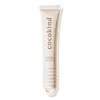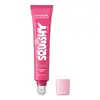What's inside
What's inside
 Key Ingredients
Key Ingredients

 Benefits
Benefits

 Concerns
Concerns

 Ingredients Side-by-side
Ingredients Side-by-side

Polybutene
Ethylhexyl Palmitate
EmollientCaprylic/Capric Triglyceride
MaskingHydrogenated Castor Oil
EmollientStearalkonium Hectorite
Gel FormingRicinus Communis Seed Oil
MaskingGlycerin
HumectantCeramide NP
Skin ConditioningCeramide AP
Skin ConditioningPortulaca Pilosa Extract
Skin ConditioningTocopherol
AntioxidantVaccinium Macrocarpon Seed Oil
Skin ConditioningHelianthus Annuus Seed Oil
EmollientPalmitoyl Tripeptide-38
Skin ConditioningCetearyl Ethylhexanoate
EmollientIsostearyl Isostearate
EmollientPolyglyceryl-3 Diisostearate
EmulsifyingPolyglyceryl-3 Polyricinoleate
EmulsifyingSorbitan Isostearate
EmulsifyingSucrose Cocoate
EmulsifyingTitanium Dioxide
Cosmetic ColorantPolybutene, Ethylhexyl Palmitate, Caprylic/Capric Triglyceride, Hydrogenated Castor Oil, Stearalkonium Hectorite, Ricinus Communis Seed Oil, Glycerin, Ceramide NP, Ceramide AP, Portulaca Pilosa Extract, Tocopherol, Vaccinium Macrocarpon Seed Oil, Helianthus Annuus Seed Oil, Palmitoyl Tripeptide-38, Cetearyl Ethylhexanoate, Isostearyl Isostearate, Polyglyceryl-3 Diisostearate, Polyglyceryl-3 Polyricinoleate, Sorbitan Isostearate, Sucrose Cocoate, Titanium Dioxide
Polybutene
Hydrogenated Polyisobutene
EmollientRicinus Communis Seed Oil
MaskingTridecyl Trimellitate
EmollientCoco-Caprylate/Caprate
EmollientSqualane
EmollientDi-PPG-3 Myristyl Ether Adipate
EmollientMica
Cosmetic ColorantSynthetic Wax
AbrasiveButyrospermum Parkii Butter
Skin ConditioningParfum
MaskingSilica
AbrasiveLinoleic Acid
CleansingSodium Hyaluronate
HumectantTocopheryl Acetate
AntioxidantOleic Acid
EmollientHydrogenated Castor Oil
EmollientZingiber Officinale Root Extract
MaskingPalmitic Acid
EmollientStearic Acid
CleansingVanillin
MaskingTocopherol
AntioxidantLinolenic Acid
CleansingCI 15850
Cosmetic ColorantCI 19140
Cosmetic ColorantPolybutene, Hydrogenated Polyisobutene, Ricinus Communis Seed Oil, Tridecyl Trimellitate, Coco-Caprylate/Caprate, Squalane, Di-PPG-3 Myristyl Ether Adipate, Mica, Synthetic Wax, Butyrospermum Parkii Butter, Parfum, Silica, Linoleic Acid, Sodium Hyaluronate, Tocopheryl Acetate, Oleic Acid, Hydrogenated Castor Oil, Zingiber Officinale Root Extract, Palmitic Acid, Stearic Acid, Vanillin, Tocopherol, Linolenic Acid, CI 15850, CI 19140
 Reviews
Reviews

Ingredients Explained
These ingredients are found in both products.
Ingredients higher up in an ingredient list are typically present in a larger amount.
Hydrogenated Castor Oil is created by adding hydrogen to castor oil. This helps stabilize the castor oil and raises the melting point. At room temperature, hydrogenated castor oil is solid.
Castor Oil helps moisturize the skin. It is rich in a fatty acid called ricinoleic acid. This fatty acid helps prevent moisture loss on the skin. This helps keep your skin soft and hydrated. Ricinoleic acid also has anti-inflammatory and pain reducing properties.
As a wax-like substance, Hydrogenated Castor Oil acts as an emollient. Emollients help keep your skin stay soft and smooth by creating a barrier. This barrier helps trap moisture.
Hydrogenated Castor Oil may not be fungal-acne safe. We recommend speaking with a professional.
Learn more about Hydrogenated Castor OilPolybutene is used to help control the viscosity of a product. This just means it helps adjusts the texture.
It is a polymer and does not get absorbed into the skin due to its large size.
Studies found this ingredient did not irritate skin in concentrations below 15%.
Learn more about PolybuteneRicinus Communis Seed Oil is the INCI name for castor oil.
Castor Oil helps moisturize the skin. It is rich in a fatty acid called ricinoleic acid. This fatty acid helps prevent moisture loss on the skin. This helps keep your skin soft and hydrated. Ricinoleic acid also has anti-inflammatory and pain reducing properties.
Besides hydrating the skin, castor oil is also used to hydrate hair. By keeping the hair shaft moisturized, breakage is decreased. More studies are needed to show castor oil's effective on stimulating hair growth.
Castor oil is created by cold-pressing castor seeds and then purifying the oil with heat. It was used in Ancient Egypt as fuel in lamps and to help treat eye irritation.
The term 'fragrance' is not regulated in many countries. In many cases, it is up to the brand to define this term. For instance, many brands choose to label themselves as "fragrance-free" because they are not using synthetic fragrances. However, their products may still contain ingredients such as essential oils that are considered a fragrance.
Learn more about Ricinus Communis Seed OilTocopherol (also known as Vitamin E) is a common antioxidant used to help protect the skin from free-radicals and strengthen the skin barrier. It's also fat soluble - this means our skin is great at absorbing it.
Vitamin E also helps keep your natural skin lipids healthy. Your lipid skin barrier naturally consists of lipids, ceramides, and fatty acids. Vitamin E offers extra protection for your skin’s lipid barrier, keeping your skin healthy and nourished.
Another benefit is a bit of UV protection. Vitamin E helps reduce the damage caused by UVB rays. (It should not replace your sunscreen). Combining it with Vitamin C can decrease sunburned cells and hyperpigmentation after UV exposure.
You might have noticed Vitamin E + C often paired together. This is because it is great at stabilizing Vitamin C. Using the two together helps increase the effectiveness of both ingredients.
There are often claims that Vitamin E can reduce/prevent scarring, but these claims haven't been confirmed by scientific research.
Learn more about Tocopherol